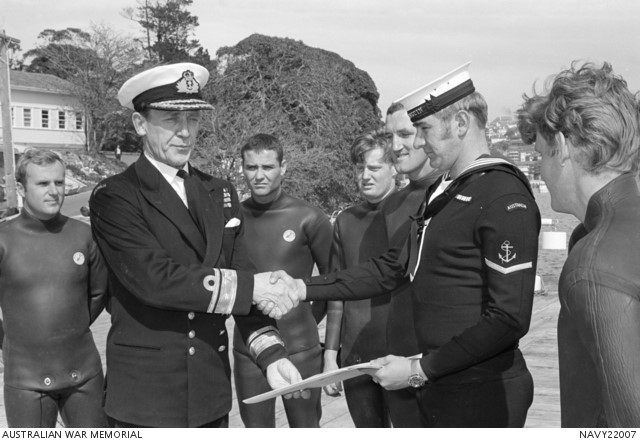Data extracted from John Perryman & Brett Mitchell, Australian Navy in Vietnam: Royal Australian Navy Operations 1965 – 1972, p.70-73. Reprinted with the kind permission of the Authors.
Photographs from the Australian War Memorial Collection licensed under CC BY-NC
Unit: Clearance Diving Team 3
Composition:
- LEUT A.A. Davis, RAN
- CPOCD A.V. Rashleigh
- POCD J.R. Brumley
- ABCD M.H. Ey
- ABCD J.L. Garrett
- ABCD A.J. Sherlock
Deployment: February 1969 to August 1969
The fifth contingent arrived in Saigon on 11 February and assumed full responsibility for CDT3’s operations on 26 February 1969. The outgoing contingent remained on as advisers until they left Vietnam at the beginning of March.
Night diving operations, which had begun in early February 1969, continued, and by the end of March had become a routine event. For the new team, maximum safety was the order of the day when it came to this new aspect to STABLEDOOR. Initially there was some resistance from the attending boat coxswains who experienced difficulty supporting the divers at night and in varying weather conditions. The divers too, held concerns that checking ships’ cables at night by feel was only effective against floating explosive charges. The most disturbing development was the appearance in other areas of Vietnam of a new Soviet sabotage charge, similar to a limpet mine. This nasty device was designed to be attached magnetically to a ship’s hull and was initiated by time-delay fuses and fitted with an anti-removal device. This was something that this contingent would encounter later in their deployment.
The established EOD exchange program continued and both Petty Officer Brumley and Able Seaman Garrett were detached to Saigon to work with EODMUPAC Team 33. In return, Aviation Ordnance-man First Class (AOI) Beyer joined CDT3 for ten days. The following month, Brumley and Able Seaman Ey were rotated with two USN Petty Officers from Da Nang. On 26 March AOI Beyer accompanied Chief Petty Officer Rashleigh and Able Seaman Sherlock into the Rung Sat Special Zone in response to a call for assistance from the 33rd Coastal group, Cat Lo. The previous evening, a local Junk Force sprang an ambush against a sampan, killing the four VC occupants. Assistance were required to remove the bodies and arms from the wreck. Sherlock dived into a thin veil of mud, located one body and recovered a valuable assortment of weapons and documents.
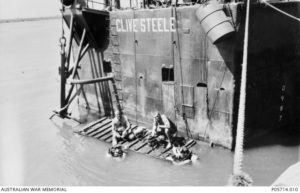
Members of the 5th Contingent, Clearance Diving Team 3 (CDT3) change a starboard propeller on the ship AV Clive Steele. (AWM 78, Clearance Diving Team Three, Report of Proceedings, March 1969.)
With CDT3 now permitted to participate as EOD specialists in SEAL-type operations, the fifth contingent began a series of operations that took team members into the confined rivers and canals of the Mekong Delta. Some of these were conducted under the auspices of SEALORDS (Southeast Asia, Lake, Ocean, River, Delta Strategy). Launched in October 1968, SEALORDS was developed by the newly appointed COMNAVFORV, Vice Admiral Elmo R. Zumwalt Jr. SEALORDS had four primary objectives: to interdict VC infiltration routes from Cambodia and along the canals from the Bassac River to the Gulf of Thailand; pacify the trans-delta waterways; pacify and clear the Tan Dinh and Dung Island complexes in the Bassac River, and, to harass the enemy. The effectiveness of riverine raids into VC controlled areas clearly became evident when long barricades began to appear in many rivers and canals as the VC fought to disrupt riverine operations.
On 25 March 1969, Lieutenant Davis examined a series of aerial photos showing a long barricade across the Rach Cai Bai in the district of Thanh Phu, and was asked to assess whether it could be cleared. The Rach Cai Bai was a known trouble spot, and previous attempts by American forces to penetrate the river had failed with a boat being mined and another hit by B41 rockets. As such, the hazardous nature of any operation into the area could not be underestimated. For this reason Davis limited CDT3’s participation to two volunteers, Chief Petty Officer Rashleigh and Able Seaman Sherlock.
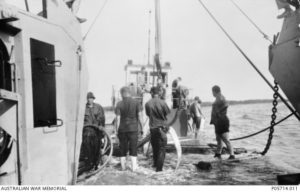
Members of the 5th Contingent, Clearance Diving Team 3 (CDT3) carry out salvage operations on a tug which had foundered in the mouth of the Cua Soi Rap River. (AWM 78, Clearance Diving Team Three, Report of Proceedings, March 1969.)
Four swift boats, PCFs 28, 32, 62 and 98, were allocated to the mission planned for 29 March. Rashleigh and Sherlock sailed in PCF 32 with three US salvage divers from harbour Clearance Unit One. PCF’s 28 and 32 entered the Rach Cai Bai from the south and transited the river to the point where the barricade lay, firing on targets of opportunity along the river banks. The barricade was constructed of Nipa palm logs bound together with fencing and barbed wire. The explosive used to remove the obstacle was the 50lbs Mk8 Mod2 Hose Charge, which comprised 70% plastic explosive and 30% aluminium powder. It was ideal for underwater demolition operations. The hose charge was simple to use and easily detonated by wrapping half a dozen turns of detonation cord around the end of the charge. Throughout the operation, the swift boats and the embarked security force provided suppression fire as the divers placed eight hose charges in position.
Having destroyed the barricade, the swift boats proceeded further north to the junction with the Rach Bang Cung and rendezvoued with PCF’s 62 and 98, which had entered the river from the north via the Rach Sau canal. A security force was then landed to sweep down the banks of the Rach Eo Loi. As they were re-embarked further down river, all four swift boats received small arms fire, wounding two of those on board. Fire was returned before PCFs 28 and 32 continued down the Rach Eo Lio to the Song Co Chien, while PCFs 62 and 98 exited to the north.
CDT2 repeated the operation in the Rach Cai Bai on 19 May 1969, although on this occasion there were three barricades plus a bridge to destroy. Four swift boats were assigned to this SEALORDS operation. Having destroyed their targets without incident, the force of swift boats rendezvoued in the Rach Bang Cung before probing the Rach Con Oc and Rach Ba, drawing enemy fire while transiting north along the Rach Con Oc. PCF 59, to which the Australians were embarked, reported the range of fire at only ten yards. During the engagement the boat’s forward gunner, Boatswains Mate Third Class Thompson, was severely wounded. The units immediately cleared the narrow waterways and exited into the Song Ham Luong where Thompson was evacuated. His wounds, however, proved to be fatal. The intensity of riverine operations is amply demonstrated by the ammunition expended by PCF 59 during this operation: .50 calibre (6,000 rounds), 7.62 mm (4,000), 5.56mm (500), 81mm (70), 40mm grenades (50), hand grenades (20) and light anti-tank rockets (10).
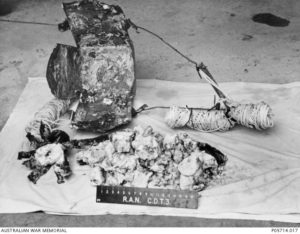
A Viet Cong home-made mine recovered from Vung Tau on 23 May 1969, by the 5th Contingent, Clearance Diving Team 3 (CDT3). (AWM 78, Clearance Diving Team Three, Report of Proceedings, May 1969.)
Following a relatively uneventful period for ships in Vung Tau, enemy swimmers returned in the early hours of 23 May. Shortly after 0100, sentries on board USS Hickman County (LST 825) reported seeing swimmers in the water off the De Long Pier. The sappers were taken under fire and concussion grenades were dropped over the ship’s side. Chief Petty Officer Rashleigh, who was leading CDT3 in the temporary absence of Lieutenant Davis, arrived at the pier with Able Seaman Ey and Garrett at 0145, by which time one swimmer had been captured. An object had also been discovered suspended between the pier and the MV Heredia alongside. Garrett entered the water, ignoring the presence of enemy swimmers in the immediate vicinity and found a metal container (18” x 12” x 12”) suspended some 12 feet below the surface. While he was out of the water reporting this information to Rashleigh, who had since been joined by Petty Officer Brumley and Able Seaman Sherlock, a small explosion was heard beneath them. Garrett re-entered the water to find that the improvised device had actuated, but fortunately, the main charge, estimated to be 40lbs of C4 explosive, had not detonated. At 0410, while the team searched the pier for evidence of more mines, another VC sapper was captured and taken prisoner.
After a short break to recharge the team’s diving equipment at the Harbour Entrance Control post, the Australians returned to the pier to continue a more thorough search at daybreak. It did not take them long to locate a Soviet BPM-2 limpet mine attached to the northern side of the pier. This was removed with the help of a River Patrol Boat. The two enemy sappers were later interrogated and revealed that a second BPM-2 limper mine had been dropped during their assault. This was recovered on 27 May, intact and complete with its floatation tube, and provided EOD personnel with valuable intelligence on how to counter this threat.
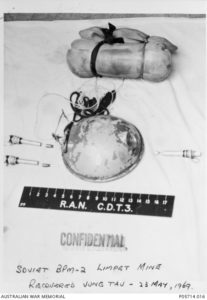
Components of a Soviet BPM-2 Limpet mine recovered from the Vung Tau pier by the 5th Contingent, Clearance Diving Team 3 (CDT3) after a swimmer sapper attack at Da Long Pier on 23 May 1969. (AWM 78, Clearance Diving Team Three, Report of Proceedings, May 1969.)
The events of 23 May 1969 earned Garrett a mention in despatches for ‘personal courage, devotion to duty and professionalism under extremely hazardous conditions’. Rashleigh too was decorated, receiving the British Empire Medal for ‘inspired leadership and personal courage and professionalism and steadfastness in an extremely hazardous situation’.
The sudden appearance of well-trained sappers in Vung Tau equipped with Soviet BPM-2 limpet mines was a worrying development that changed the concept of ship defence overnight. Lieutenant Davis believed that a more realistic approach was vital as it was impractical to conduct a thorough hull search on every ship in the anchorage. He therefore recommended that shipping clear the harbour at sunset and return to the anchorage in the morning. This was the procedure followed by Sydney and her escorts whenever they were required to be Vung Tau for more than a day. Highlighting his concerns, personnel from USS Tutuila (ARG 4) claimed to have seen a swimmer alongside and requested a bottom search by CDT3. Davis was scathing in this report, explaining that ‘no shots had been fired, no concussion charges had been dropped and the five ship’s divers borne had never carried out a search of the hull and would not know how the tackle the problem’. Fortunately, nothing untoward was found.
On 16 June 1969, three team members participated in a further sweep for mines reportedly laid in the Rach Thau Rau near Ap Giong Dai, Vinh Binh Province. On this occasion, however, no trace of enemy mines was found.
One week later, members of CDT3 participated in two separate operations over consecutive evenings. Late on 23 June the team was requested to clear another large log barricade which was stalling a riverine operation in the Long Phu District of Ba Xuyen Province. Two team members were embarked in a swift boat and transferred to another mid-way for the reminder of the eight-hour overnight passage to Long Phu, where a seven-row barricade was destroyed without incident. The following evening, they received a call for immediate assistance in support of a Vietnamese Junk Force operation north east of Long Son Island. The South Vietnamese had successfully ambushed a motorised sampan, killing five VC. CDT3 was required to search the river bed for bodies, weapons and other items. One body was retrieved along with weapons and a container of documents, which later proved to be of great interest to the South Vietnamese.
July 1969 passed quietly in comparison to the preceding months. Monsoonal weather, dominated by high winds and tropical downpours, curtailed many diving operations, and only 22 ships’ cables were inspected. Their final weeks were spent conducting routine EOD operations in the Vung Tau area and finalising the handover to the incoming contingent. Four team members departed for Australia on 20 August, followed by Lieutenant Davis and Chief Petty Officer Rashleigh on 3 September.
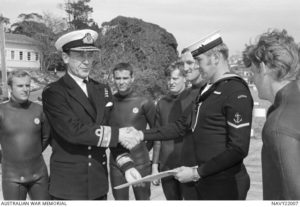
At the RAN Diving School, HMAS Penguin, Rear Admiral (Rear Adm) G J B Crabb CBE DSC RAN, Flag Officer Commanding East Australia Area, is presenting a Mentioned in Despatches citation to R64687 Leading Seaman Clearance Diver (LSCD) Jeffrey Lynden Garrett, for his services in Vietnam with the Clearance Diving Team 3 (CDT3). Left to right: R94293 Able Seaman Clearance Diver (ABCD) John Cecil Pocklington, of Sydney, NSW; Rear Adm Crabb; Private D Pike, of Randwick, NSW, and of the Australian Army; Engineering Mechanic (ME) H Smith; R62377 Petty Officer Phillip Charles (Phil) Kember, of Sydney, NSW; LSCD Garrett; unidentified.

